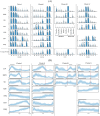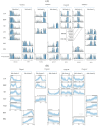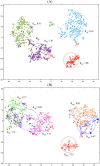Generalizability of motor modules across walking-based and in-place tasks - a distribution-based analysis on total knee replacement patients
- PMID: 40260015
- PMCID: PMC12009812
- DOI: 10.3389/fbioe.2025.1471582
Generalizability of motor modules across walking-based and in-place tasks - a distribution-based analysis on total knee replacement patients
Abstract
Introduction: There are evidences that the nervous system produces motor tasks using a low-dimensional modular organization of muscle activations, known as motor modules. Previous studies have identified characteristic motor modules across similar tasks in healthy population. This study explored the generalizability of motor modules across two families of walking-based (level-walking, downhillwalking and stair-decent), in-place ascending (sit-to-stand, squat-to-stand), and in-place descending (stand-to-sit and stand-to-squat) motor tasks in a group of six individuals undergone total knee replacement (TKR) surgery. Methods: Motor modules were extracted from the EMG data of CAMS-Knee dataset using non-negative matrix factorization technique. A distribution-based approach, employing three levels of k-means clustering, was then applied to find the shared and task-specific modules, and assess their representability among the whole task-trial data. Results and Discussion: Results indicated a four- and a seven-subcluster arrangement of the shared and task-specific motor modules, depending upon the membership criteria. The first arrangement revealed motor modules which were shared across all tasks (min coverage index: 76%; modules' distinctness range: 7.08-8.91) and the latter among tasks of the same family mainly, although there remained some interfamily shared modules (min coverage index: 81%; modules' distinctness range: 7.17-9.89). It was concluded that there are shared motor modules across walking-based and in-place tasks in TKR individuals, with their generalizability and representability depending upon the analysis method. This finding highlights the importance of the analysis method in identifying the shared motor modules, as the main building blocks of motor control.
Keywords: clustering; k-means; non-negative matrix factorization; shared modules; synergy analysis.
Copyright © 2025 Darvishi, Daroudi, Tavasoli, Shafiezadeh and Farahmand.
Conflict of interest statement
The authors declare that the research was conducted in the absence of any commercial or financial relationships that could be construed as a potential conflict of interest.
Figures




Similar articles
-
Modularity underlying the performance of unusual locomotor tasks inspired by developmental milestones.J Neurophysiol. 2020 Feb 1;123(2):496-510. doi: 10.1152/jn.00662.2019. Epub 2019 Dec 11. J Neurophysiol. 2020. PMID: 31825715
-
CONSISTENCY OF DYNAMIC KNEE VALGUS KINEMATICS AND PAIN ACROSS FUNCTIONAL TASKS IN FEMALES WITH PATELLOFEMORAL PAIN: A CROSS-SECTIONAL STUDY.Int J Sports Phys Ther. 2020 Dec;15(6):985-994. doi: 10.26603/ijspt20200985. Int J Sports Phys Ther. 2020. PMID: 33344015 Free PMC article.
-
Increased neuromuscular consistency in gait and balance after partnered, dance-based rehabilitation in Parkinson's disease.J Neurophysiol. 2017 Jul 1;118(1):363-373. doi: 10.1152/jn.00813.2016. Epub 2017 Apr 5. J Neurophysiol. 2017. PMID: 28381488 Free PMC article.
-
Using a Module-Based Analysis Framework for Investigating Muscle Coordination during Walking in Individuals Poststroke: A Literature Review and Synthesis.Appl Bionics Biomech. 2018 Jun 3;2018:3795754. doi: 10.1155/2018/3795754. eCollection 2018. Appl Bionics Biomech. 2018. PMID: 29967653 Free PMC article. Review.
-
Contributions to the understanding of gait control.Dan Med J. 2014 Apr;61(4):B4823. Dan Med J. 2014. PMID: 24814597 Review.
References
-
- Andriollo L., Montagna A., Mazzella G. G., Sangaletti R., Benazzo F., Rossi S. M. P. (2024). Navigated versus conventional medial unicompartmental knee arthroplasty: minimum 18 years clinical outcomes and survivorship of the original Cartier design. Knee 49, 183–191. 10.1016/j.knee.2024.07.009 - DOI - PubMed
LinkOut - more resources
Full Text Sources

